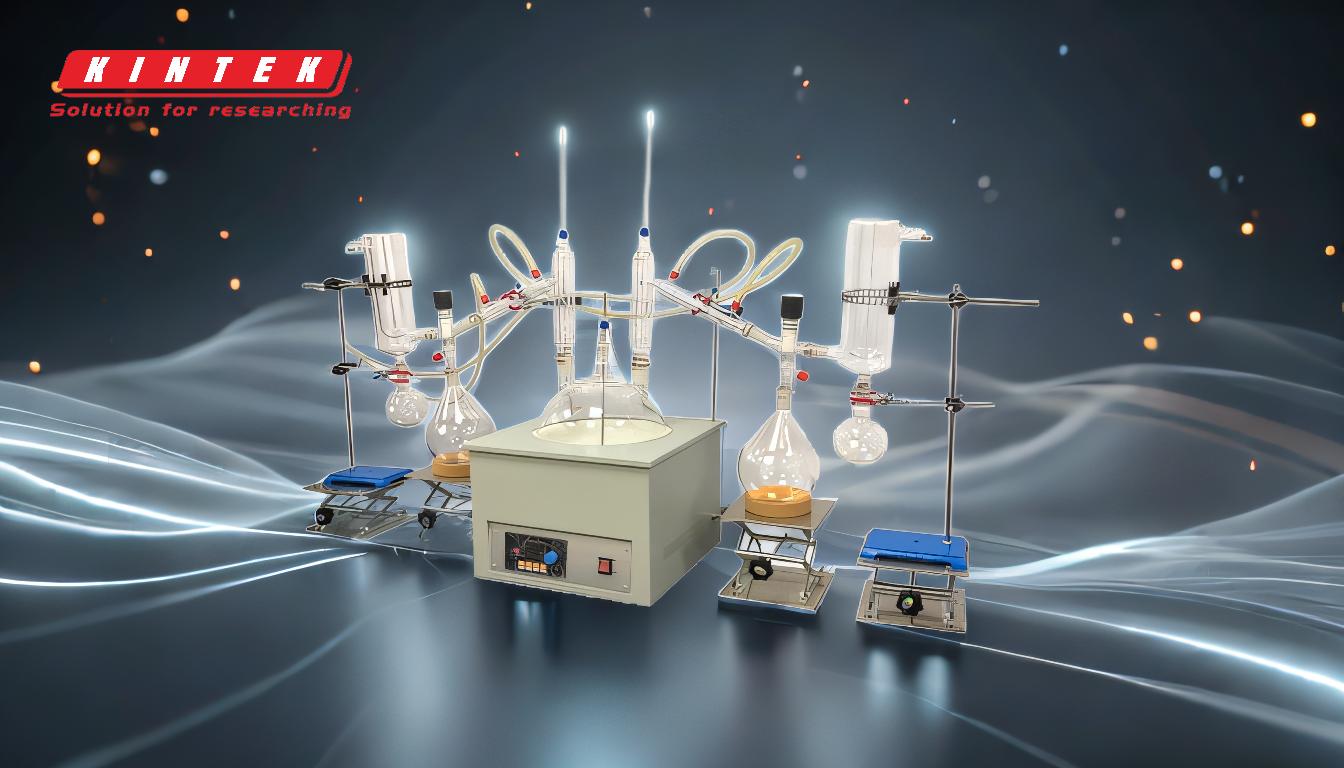Short path thin film distillation is a specialized distillation technique used to separate and purify compounds, particularly those that are heat-sensitive or have high boiling points. It operates under high vacuum conditions, which significantly lowers the boiling points of the substances, allowing for efficient separation at lower temperatures. The process involves heating a liquid solution in an evaporating flask, causing its components to vaporize. These vapors travel a short distance to a condensing surface, where they are cooled and condensed back into liquid form. The distillate is then collected in separate flasks based on the weight and volatility of the components, enabling precise separation and refinement of the desired compounds.
Key Points Explained:

-
Principle of Operation:
- Short path thin film distillation relies on the principle of reducing pressure to lower the boiling points of substances. This is achieved by creating a high vacuum within the distillation apparatus.
- The pressure difference between the boiling film and the condensing surface drives the flow of steam, allowing for efficient separation of compounds.
-
Components of the Apparatus:
- Evaporating Flask: The liquid solution is placed in an evaporating flask, which is heated gradually to reach the boiling points of its components.
- Condensing Unit: The vapors travel a short distance to a condensing unit, where they are cooled and condensed back into liquid form.
- Receiving Flasks: The condensed liquid is collected in separate receiving flasks based on the weight and volatility of the components.
-
Process Steps:
- Heating: The liquid solution is heated in the evaporating flask, causing its components to vaporize.
- Vaporization: The vapors travel a short distance to the condensing unit.
- Condensation: The vapors are cooled and condensed back into liquid form in the condensing unit.
- Collection: The condensed liquid is collected in separate receiving flasks based on the weight and volatility of the components.
-
Advantages:
- Efficiency: The short distance between the evaporating flask and the condensing unit minimizes distillate loss and allows for efficient separation.
- Precision: The process allows for precise separation and refinement of desired compounds, making it ideal for laboratory applications.
- Suitability for Heat-Sensitive Materials: The low operating temperatures make it suitable for heat-sensitive and high-boiling-point materials.
-
Applications:
- Laboratory Applications: Short path thin film distillation is commonly used in laboratory settings for the purification of heat-sensitive compounds.
- Industrial Applications: It is also used in industries for the refinement of oils, cannabinoids, and other complex mixtures.
-
Key Considerations:
- Vacuum Conditions: Maintaining high vacuum conditions is crucial for the success of the distillation process.
- Temperature Control: Precise control of heating temperatures is necessary to ensure efficient separation and prevent degradation of heat-sensitive materials.
- Equipment Design: The design of the distillation apparatus, particularly the short distance between the evaporating flask and the condensing unit, is critical for minimizing distillate loss and maximizing efficiency.
In summary, short path thin film distillation is a highly efficient and precise method for separating and purifying compounds, particularly those that are heat-sensitive or have high boiling points. Its operation under high vacuum conditions and the short distance between the evaporating and condensing units make it an ideal choice for both laboratory and industrial applications.
Summary Table:
| Aspect | Details |
|---|---|
| Principle | Reduces pressure to lower boiling points, enabling efficient separation. |
| Key Components | Evaporating flask, condensing unit, and receiving flasks. |
| Process Steps | Heating → Vaporization → Condensation → Collection. |
| Advantages | High efficiency, precise separation, and suitability for heat-sensitive materials. |
| Applications | Laboratory purification, industrial refinement of oils, cannabinoids, etc. |
| Key Considerations | High vacuum conditions, precise temperature control, and optimized equipment design. |
Learn more about how short path thin film distillation can enhance your processes—contact our experts today!












